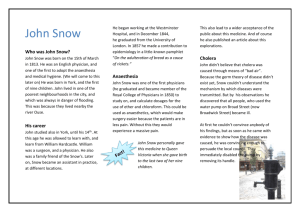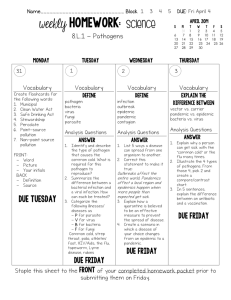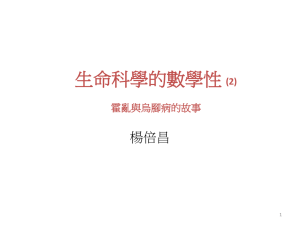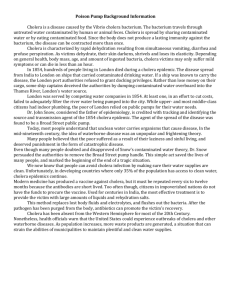Lowy-Concepts_of_ID
advertisement
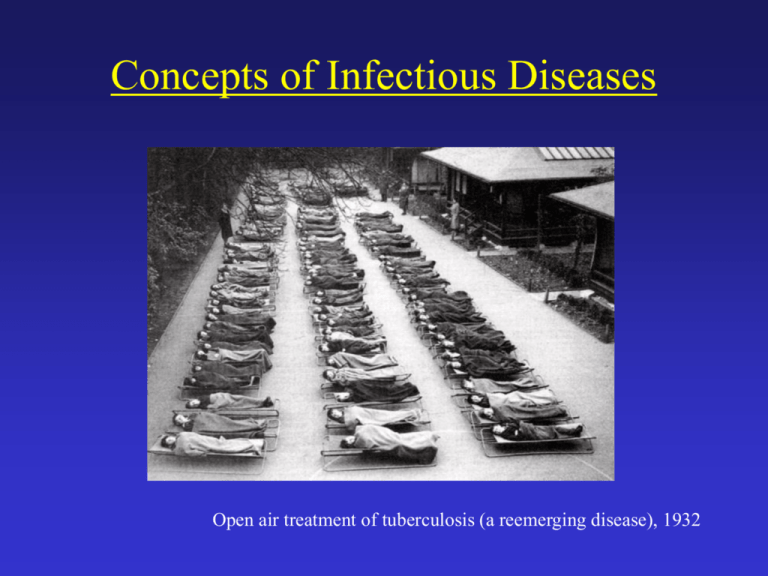
Concepts of Infectious Diseases Open air treatment of tuberculosis (a reemerging disease), 1932 Subjects to be Covered • Historical perspective • Terminology and concepts of infectious diseases • Pathway to infection • Sequence of steps necessary for infection • Microbial virulence and strategies to evade the host Girolamo Fracastoro (1478-1553) Among the first to theorize on the principle of “contagion” by direct contact, fomites (contaminated particles) and air • Battled the concept of “spontaneous generation” – Microbes, etc. arise from putrefying matter • Discovered the role of anthrax in fatal illness of sheep – Demonstration of attenuation for vaccine development • Development of a vaccine to treat rabies again using the concept of attenuation Louis Pasteur (1822-1895) • 1844 appointed as lecturer at the Univ. of Vienna Allegemeines Krankenhaus • Found increased mortality from puerperal fever among the first vs. second clinic • Suspected “cadaverous particles” from the autopsy room • Instituted handwashing with chlorinated lime solution • Mortality reduced from ~12% to 3% • After he left his work was discounted and ignored Ignaz Semmelweis 1818-1865 Maternal Mortality Statistics 1784-1858 Vienna Lying-In Hospital Hand-Washing Patterns in a Medical Intensive Care Unit Group Physicians Nurses Respiratory therapists Radiology technicians Others Total Albert and Condie, NEJM 1981 No. Contacts Followed by Washing / Total No. Contacts (%) 90/236 (28) 301/701 (43) 91/120 (76) 7/16 (44) 5/49 (10) 494/1212 (41) The Tale of the Broad Street Pump • Outbreak of cholera in London - 1854 • > 500 fatalities within a radius of 250 yards and within 10 days • Snow investigated 77 cases - of these 59 used the Broad street pump • The epidemic was interrupted when the handle of the pump was removed John Snow 1813-1858 150th Anniversary of John Snow and the Pump Handle John Snow, M.D. (1813--1858), a legendary figure in epidemiology, provided one of the earliest examples of using epidemiologic methods to identify risk for disease and recommend preventive action (1). Best known for his work in anesthesiology, Snow also had an interest in cholera and supported the unpopular theory that cholera was transmitted by water rather than through miasma (i.e., bad air). On August 31, 1854, London experienced a recurrent epidemic of cholera; Snow suspected water from the Broad Street pump as the source of disease. To test his theory, Snow reviewed death records of area residents who died from cholera and interviewed household members, documenting that most deceased persons had lived near and had drunk water from the pump. Snow presented his findings to community leaders, and the pump handle was removed on September 8, 1854. Removal of the handle prevented additional cholera deaths, supporting Snow's theory that cholera was a waterborne, contagious disease. Despite the success of this investigation, the cause of cholera remained a matter of debate until Vibrio cholerae was isolated in 1883. Snow's studies and the removal of the pump handle became a model for modern epidemiology. To recognize his pioneering work, this issue of MMWR highlights public health actions guided by epidemiologic data to control a modern epidemic of cholera, detect and prevent adverse reactions to vaccinations, stop an epidemic of aflatoxin poisoning, and correct environmental causes of waterborne outbreaks. MMWR 53:783, 2004 SARS! Epidemic Curves Common source outbreak Number Subjects Infected Propagated epidemic Onset epidemic Days Henle-Koch Postulates • The organism is regularly found in the lesions of the disease • It can be isolated in pure culture on artificial media • Inoculation of the pure culture into a susceptible animal reproduces the disease • The organism can be recovered from the lesions in the infected animal Robert Koch (1843-1910) Terminology and Concepts • Pathogen: any microorganism that is capable of causing disease in a susceptible host – Primary vs. opportunistic pathogens • Colonization: establishment of an “ecological niche” for an organism, survival and replication without actual tissue invasion • Infection: the ability of an organism to invade tissue, replicate and stimulate an immune response • Intoxication: agents that cause disease by elaboration of toxin sometimes without the presence of viable bacteria Terminology and Concepts • Infectivity: the ability of an agent to cause disease in a susceptible host. • Virulence: the severity of the disease caused by the agent – e.g. rabies (uniformly fatal) vs. the common cold (minor symptoms) • Virulence determinant: a bacterial component or product that contributes to the ability of a pathogen to cause disease – may be chromosomal or on movable genetic elements such as plasmids, transposons or phages Terminology and Concepts • Infections: may vary from subclinical to fulminant • The iceberg model of infection – In many infections > 90% are asymptomatic e.g., enterovirus infections • Different pathogens cause a different frequency of clinically apparent illness – Gonorrhea (99%) vs. Polio (0.1-1.0%) Terminology and Concepts • Many bacteria can produce the same infectious disease syndrome, sometimes by completely different pathogenetic mechanisms - e.g. the sepsis syndrome • A single bacterial or viral species can cause a multitude of different diseases Natural History of Infection Categories of human infection • Asymptomatic: HIV, salmonella, commensals – Also a source of nosocomial infections • Active: subject with overt disease • Incubatory: Subject incubating but without symptoms of disease • Latent: pathogen persists in tissue without symptoms for much of the time - e.g. HIV, tuberculosis, Herpes Typhoid Mary • Worked as a cook in seven homes between 1896-1906 • Found to be shedding large numbers of S. typhi in her stools • Placed in isolation but after release changed her name and resumed cooking until located and held in custody for the rest of her life • Ultimately associated with 53 cases and three deaths “Disease usually results from inconclusive negotiations for symbiosis, an overstepping of the line by one side, a biologic misinterpretation of borders” Lewis Thomas Germs, 1974 Pathway to Infection • Reservoirs of bacterial pathogens • Means of pathogen transmission – Exogenous versus endogenous infection – Horizontal versus vertical transmission • Sites of entry • Host-pathogen interactions Reservoirs for Bacterial Pathogens Source/Reservoir Pathogens Human* T. pallidum, Hepatitis B, HIV, Commensals Animals Rabies, Leptospira, Brucella Soil Water * Single most important reservoir Clostridium tetani and botulinum, Histoplasma Legionella, Pseudomonas, Shigella Impact of Social and Environmental Factors on Risk of Disease Transmission • Construction in previously forested regions increased exposure to vectors of lyme, RMSF • Increased travel - opportunities for acquisition/spread of “exotic” infections e.g., malaria • Change in sexual habits - transmission of HIV, gonorrhea • Change in animal food production with intensive exposure to antibiotics - coupled with fast foods increase in listeria, salmonella Transmission of Microbial Pathogens Transmission of Microbial Pathogens Factors That Increase Susceptibility to Infection • • • • • • • • Extremes of age Malnutrition Genetic defects in immunity (e.g., WBC disorders) Acquired defects in immunity (e.g., AIDS) Medical diseases: diabetes, liver disease Chemotherapy, immunosuppressive agents Implantation of prosthetic material Organ transplantation Portals of Pathogen Entry Sequence of Steps Necessary for Establishment of Bacterial Infection • Adherence and colonization of host surfaces • Evasion of host defense mechanisms such as phagocytosis or intracellular killing • Adaptation to the host environment, ability to undergo change such as antigenic variation • Invasion of tissue both locally or systemically (dissemination) • Host response - often responsible for tissue damage Pili The Process of Bacterial Invasion Microbial Defense Mechanisms • Evasion of phagocytosis: – Inhibition of phagocytosis: capsules, protein A (pneumococcus, hemophilus) – Block phagolysosomal fusion (legionella, tuberculosis) – Escape lysosome (listeria, shigella) – Resist intracellular killing (S. typhi) • Concealment of antigens within cells (shigella) • Antigenic variation (neisseria, borrelia relapsing fever) Molecular Equivalent of Koch’s Postulates* • The property under investigation should be associated with pathogenic members of the species • Inactivation of the gene associated with the virulence trait should lead to a decrease in virulence • Reversion of the mutated gene restores the pathogen’s virulence * Falkow, 1988 Host Response: Barriers to Infection Bacterial Strategies to Cause Infection in the Respiratory Tract • Interference or evasion of clearance mechanisms e.g., fomites of M. tuberculosis, inhibition of ciliary activity bordetella • Target specific cellular receptors for adherence e.g., rhinovirus and ICAM-1 • Evade destruction by alveolar macrophages e.g., M. tuberculosis Pathogenesis of Host Damage Direct: poliovirus, shigella, bacterial toxins e.g., cholera toxin Immune mechanisms: excess immune response e.g., to endotoxin, peptidoglycan Hypersensitivity: allergic reactions e.g., rheumatic fever, immune complex disease, glomerulonephritis Malignant transformation: hepatitis B and liver cancer So What Do You Really Need to Know? • Terminology and concepts of infectious diseases • Vectors and different mechanisms of disease transmission • The steps involved in development of infections • Different mechanisms involved in the development of pathology in the host




